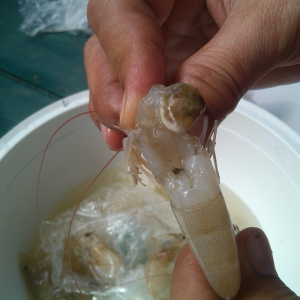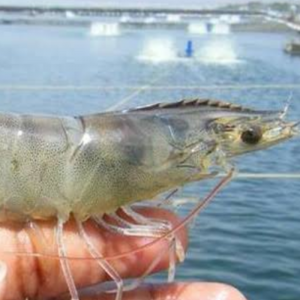
Ensuring the Water Environment of Shrimp Ponds in the Hot Season
| Fri, 16 Jul 2021 - 15:29
The hot weather is easy to change the environmental factors in the pond suddenly, causing shock, disease or premature death of the cultured shrimp.
The Environment is Easy to Change When it's Hot
Mr. Nguyen Van Tuan, a whiteleg shrimp farmer in Ninh Phu commune, Ninh Hoa town (Khanh Hoa) said that his family has 3 shrimp ponds with an area of nearly 3,000 m2. In the first crop, he collected with an output of nearly 7 tons, after deducting expenses he made a profit of more than 100 million VND. At this time, he has been raising crop 2 for nearly 2 months.
However, recently, the weather in the area has continuously occurred with hot waves. This is very easy to cause sudden changes in environmental factors in the pond, causing shock, disease or premature death of farmed shrimp.
Therefore, in order for shrimp to grow and develop well, he has always been on duty to maintain the water level in the pond from 1.2 m or more. At the same time, the water fans, he runs continuously to avoid the temperature difference between the water layers.
Read more: Intestinal Bacteriome of Pacific White Shrimp in Biofloc clear Water System
Mr. Tuan also said that, in addition to measures to combat heat for the above shrimp pond environment, he also adjusted the appropriate amount of food, added vitamins and minerals to increase the resistance of farmed shrimp.
And Mr. Le Minh Chinh, a whiteleg shrimp farmer in 3 stages applying Semi biofloc technology also in Ninh Phu commune, said that in order to proactively avoid the influence of hot weather, the hatching process was regular. Use sunshade nets. When the nursery shrimp were about to be put into the pond level 2, he started to pull the net out slowly so that the temperature between the level 2 pond and the level 1 pond was the same as the temperature before bringing the shrimp down.
In addition, when bringing shrimp to the pond, it is necessary to cause algae to create a layer to reduce the temperature, helping the shrimp to avoid heat shock. Especially in the hot season, farmers need to stock shrimp at a moderate density, the ponds must maintain a water level of 1.2m or more.
“Last time, thanks to focusing on the above solutions, despite the hot weather, my family's shrimp farming in the second crop still grew and developed well. With a farming area of 1.5 hectares, each pond is about 1,500m2 and currently has an average yield of about 2 tons/pond. It is expected that in about a month I will start harvesting, promising a good harvest," Chinh shared.
Read more: Prevenetion of Desease Caused by EHP Spores on Shrimp

In hot weather, shrimp ponds must maintain the water level above 1.2m. Photo: KS.
Recommendation
Through research, recently, the Directorate of Fisheries has issued an official dispatch on strengthening aquaculture management in hot weather in 2021. Besides, the Aquaculture Research Institute III also There have been severe weather warnings in aquaculture.
Accordingly, in recent times, the South Central provinces, especially from Da Nang to Khanh Hoa, have had extremely hot weather. The results of the local field survey show that, in the concentrated aquaculture areas of some key provinces in the South Central region, the water temperature rises by 33oC or more in the aquaculture ponds, as well as in the aquaculture ponds. in the lagoons/bays from 13 to 15 hours of the day. This is detrimental to the health of farmed fish.
Faced with the above situation, in order to proactively avoid the influence of hot weather and ensure the province's aquaculture production plan, Khanh Hoa Fisheries Sub-Department has suggested localities to guide farmers in a number of measures. measures to strengthen management of farmed objects.
According to Mr. Vo Khac En, Deputy Director of Khanh Hoa Fisheries Sub-Department, for brackish water cultured shrimp, farmers need to use nets to cover the surface to limit the radiation of sunlight and reduce the temperature. water in the pond, avoiding shock to the cultured shrimp. In particular, always maintain the water level in the pond above 1.2m.
Read more: Paddle Wheel More Cost Effective than Pump
In addition, every day farmers need to carefully siphon the pond bottom and actively store clean water to supply to the pond when necessary, such as high pH, thick algae growth, high water temperature. However, the water supply into the pond must be gradual, about 20-30% of the water in the pond, supplied in cool weather, the water supply needs to go through the pond to settle and treat.
In addition, it is necessary to strengthen the fan to limit the stratification of the water in the pond and provide enough oxygen for the shrimp, especially at night. Regularly monitor and inspect farmed shrimp, add vitamin C, minerals, and probiotics in the feed to enhance the resistance of farmed shrimp, reduce 50% of the amount of feed when it is hot and sunny. When you see that farmed shrimp have abnormal phenomenon, shrimp stop eating, shrimp color is pale, etc., they can be harvested early to avoid economic losses.
According to Mr. Vo Khac En, in order to prevent the heat of the sun for aquaculture by cages and rafts on bay lagoons, farmers need to limit new stocking, as well as collect cages and rafts without aquaculture in order to create ventilation for farmers. water surface during prolonged hot weather. For places with a lot of organic matter, it is necessary to place the cage about 1.5-2.0 m from the bottom. Arrange the distance between the cages to ensure ventilation and convenience in the process of caring, managing and cleaning the cages. Make sure the distance between the rafts is at least 50m.
Regularly clean the cage nets clean and ventilated to increase the flow rate, to improve water quality, and to increase the oxygen content in the water. Reduce 50-70% of daily feed intake or stop feeding during intense heat. Regularly diving, checking and monitoring the health of farmed aquatic products along with collecting leftovers, peeled shells and dead aquatic bodies.
When detecting abnormal changes in the water environment in the farming area or dead aquatic products, it is necessary to notify the authorities as soon as possible to take measures to prevent and deal with them promptly.
Source: Tepbac.com






















